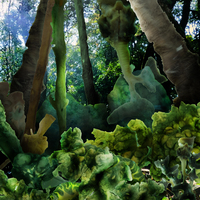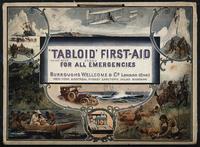Items
Site
The Medicine Chest
keywords is exactly
mountain
-

A 'Jungle'
"A ‘jungle’ consisted of a selection of pathological specimens from the Pathology Learning Centre that had been affected by typhoid fever, ascaris adult worms, yellow fever, amoebic ulcerations, tuberculosis and malaria. The diseases that afflicted these specimens were regarded as ‘tropical’. As described in Chapter One, BWC used the jungle as a significant terrain that called for a medicine chest to combat pathogens: ‘Whether you were valiantly saving your compatriot in war, traversing a dark African jungle, navigating one of the world’s first flying machines, exploring the most desolate place on earth, ascending the highest mountain in the world, or simply enjoying the windswept British coast, the chest would be there, ready for any ailment’ (Johnson 2008b: 255). BWC promoted their chests as the ideal antidote for a tropical landscape ‘at once full of potential wealth for imperial Britain, but simultaneously rife with disease’ (Johnson 2008b: 258) and claimed that the tropical colonies were ‘by far the most dangerous regions for travellers’ (BWC 1934: 8). It was here that ‘desolating ailments’ were encountered, all ‘particularly fatal to the so-called white man who originates in temperate climates’ (BWC 1934: 8). I adapted the colour of the images of afflicted intestines, livers, stomachs and brains and used them as material to construct a dense jungle that referenced this aspect of the medicine chest’s history. Printed on separate glass sections that fit into the cabinet at spaced intervals to create an illusion of depth and three-dimensionality, the work draws on the cross-sectional display technique used in many anatomy museums worldwide, in projects such as the Visible Human Project (1995) and that the artist Damien Hirst references in his works . Creating a visual link between the UCT specimens and the history of these diseases surfaces the occluded racial undertones of these understandings" (Liebenberg 2021: 267). -

The Tralfamadorians
In Kurt Vonnegut's 'Slaughterhouse-Five', the protagonist Billy, is abducted by aliens and taken to their planet, Tralfamadore. Throughout the novel, Billy imparts what he has learned from the Tralfamadorians, whilst there. In one instance, in a letter to a late night radio station, he writes about their views on time: "The most important thing I learned on Tralfamadore was that when a person dies he only appears to die. He is still very much alive in the past, so it is very silly for people to cry at his funeral. All moments, past, present, and future, always have existed, always will exist. The Tralfamadorians can look at all the different moments just the way we can look at a stretch of the Rocky Mountains, for instance. They can see how permanent all the moments are, and they can look at any moment that interests them. It is just an illusion we have here on Earth that one moment follows another one, like beads in a string, and that once a moment is gone it is gone forever. When a Tralfamadorian sees a corpse, all he thinks is that the dead person is in a bad condition in that particular moment, but that the same person is just fine in plenty of other moments. Now, when I myself hear that someone is dead, I simply shrug and say what the Tralfamadorians say about dead people, which is 'So it goes' " (Vonnegut 1969: 24 - 25). -

On the External Characters of Minerals
"The chest is designed to meet the requirements of travellers, miners, missionaries and others who need a chest of sufficient capacity to take a good supply of medicines without undue bulk and weight. It is very portable, and, on account of the material of which it is made, capable of standing hard usage" (BWC 1934: 24). -

On the External Characters of Minerals
"The chest is designed to meet the requirements of travellers, miners, missionaries and others who need a chest of sufficient capacity to take a good supply of medicines without undue bulk and weight. It is very portable, and, on account of the material of which it is made, capable of standing hard usage" (BWC 1934: 24). -

Situations in which a Tabloid medicine chest made by BWC would be useful.
Situations in which a Tabloid medicine chest made by Burroughs Wellcome and Co. would be useful. Colour process print, ca. 1909. The Tabloid medicine chests were distributed free to well known explorers such as H.M Stanley and Ernest Shackleton. The word 'tabloid' was coined by the firm of Burroughs Wellcome and registered as a trademark.


